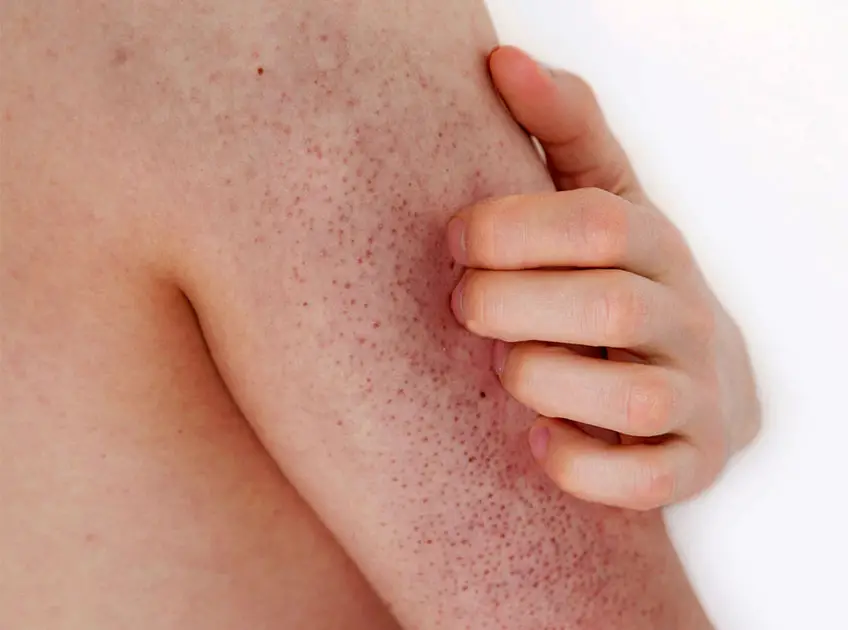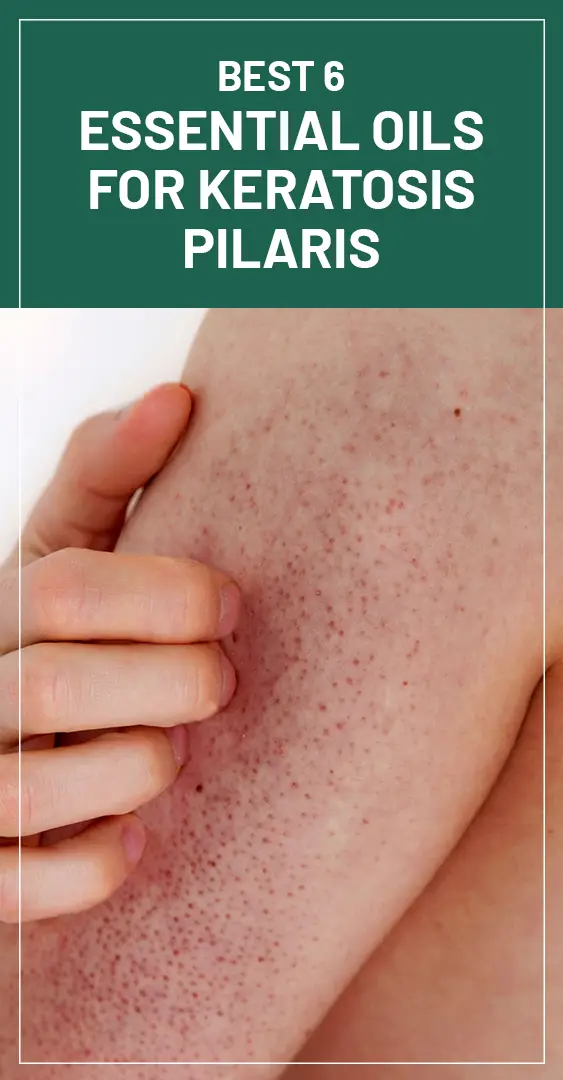
Important: This article is for informational purposes only. Please read our full disclaimer for more details.
Essential oils have been one potent remedy for various skin disorders. It is due to their antibacterial, anti-inflammatory, and antiseptic properties.
As many people struggle to treat keratosis pilaris, plenty of cures and antidotes for it are surfacing all over the internet. However, one that proves highly effective and beneficial is the use of essential oils.
Essential oils have gained traction in recent years for their truly amazing healing properties. They are used as a powerful weapon against bumps that occur in keratosis pilaris.
Before listing the most effective essential oils for keratosis pilaris, let’s dive into this dreadful skin disorder and know a little more about it.
What Is Keratosis Pilaris?
Keratosis pilaris is a genetic condition that results in hard and itchy bumps on the skin. Although these bumps can occur in any part of the body, they are usually found on the thighs, buttocks, and upper arms.
Who Can Get Keratosis Pilaris?
Keratosis pilaris may occur due to different reasons-
1. Pre-existing Skin Condition- People with dry or eczema-prone skin are more susceptible to getting keratosis pilaris.
2. Genetics- According to research, genetics is one of the risk factors for getting this disease. The study reveals that out of 49 keratosis pilaris patients, 39% have a family history with the same skin issue.
3. Obesity- Excess body weight puts people at a higher risk of getting keratosis pilaris. A study conducted on 109 overweight and obese people revealed that 42% were suffering from keratosis pilaris. High BMI has a direct correlation with the development of this skin condition.
Treating Keratosis Pilaris With Essential Oils
Essential oils are concentrated compounds extracted from plants. They are extensively used in aromatherapy as the chemicals in essential oils stimulate the limbic system and heal skin conditions.
Since one of the reasons for keratosis pilaris is dry and scaly skin, keeping it well-moisturized and deeply nourished with essential oils help abundantly. These plant oils are absorbed by the skin and helped by-
- Making the skin soft and supple
- Relieving itchiness
- Reducing inflammation and redness
- Preventing the development of microbes and germs
Some of the most beneficial essential oils for keratosis pilaris include the following-
1. Tea Tree Oil

Tea tree essential oil is one of the most common and effective remedies for keratosis pilaris. It helps soothe itching and burning sensations. The antibacterial and anti-inflammatory properties of tea tree oil protect keratosis pilaris infected skin from getting further infections.
How To Use:
- Mix an equal amount of tea tree essential oil with a carrier oil like coconut or olive oil.
- Apply a few drops over the affected areas twice a day.
- Avoid applying it over sensitive areas like eyes, earlobes, or nostrils.
2. Lavender Oil

Lavender oil is one of the common essential oils used in aromatherapy and skin care products, and for many good reasons. The analgesic, anti-inflammatory, and soothing properties of lavender oil heal the protective barrier of skin that gets wounded due to keratosis pilaris.
Additionally, lavender oil aids in new skin cell regeneration and eases pain and irritation. At the same time, the antibacterial properties ensure skin remains protected from microbe infestation.
How To Use:
- Mix two drops of lavender oil with one tablespoon of any carrier oil.
- Apply gently over the affected areas.
- You can also let the mixture stay overnight to reduce flare-ups.
3. Frankincense Oil
The potent compounds of Frankincense Oil make it a natural healer for multiple skin issues. From deeply moisturizing the skin to improving skin’s elasticity and tone, Frankincense Oil works wonders in different ways.
Loaded with anti-inflammatory properties, this oil heals skin with keratosis pilaris and remodels it.
How To Use:
- Take an equal amount of frankincense essential oil and a carrier oil and mix them well.
- Apply two drops of this mixture to the affected areas twice daily.
[Read : The 10 Best Essential Oils for Acne]
4. Lemongrass Oil
Soothing the irritated skin and preventing infection, lemongrass oil is popular for its multiple skin benefits. It tones and purifies the skin, relieving redness and itching, and treats inflammation associated with keratosis pilaris.
How To Use:
- Create a blend of lemongrass oil and any carrier oil of your choice by adding a few drops of both,
- Apply it over the affected areas of the skin to get relief from the symptoms immediately.
- You can also use lemongrass oil alone on the keratosis pilaris-prone areas.
5. Chamomile Oil
The antibacterial activity of chamomile oil speeds up wound healing due to keratosis pilaris. At the same time, it reduces the skin’s allergic reactivity.
Chamomile oil is deeply nourishing and provides instant soothing to irritated skin.
How To Use:
- Mix five drops of chamomile oil with one teaspoon of carrier oil like coconut oil or jojoba oil.
- Apply this blend to the affected areas twice a day for the best results.
6. Eucalyptus Oil
One of the most popular essential oils, eucalyptus oil, is highly beneficial for different skin conditions, including keratosis pilaris. It provides moisturization to dry, itchy and irritated skin. Also, it provides relief from painful skin rashes.
The antiseptic properties help eliminate further skin infections over the flare-ups. It is one of the reasons eucalyptus oil is often found in acne creams, skin lotions, and different skincare treatments for cols, pimples, and rashes.
How To Use:
- Dilute one drop of eucalyptus oil with two tablespoons of jojoba oil, coconut oil, or almond oil.
- Apply it over the affected areas and gently massage for good results.
- You can also leave the blend overnight and wash it off in the morning.
[Read : 10 Best Essential Oils for Headaches]
7. Myrrh Essential Oil
Popular for its anti-inflammatory, antifungal, and antibacterial properties, myrrh oil can be a good addition to the list of essential oil for keratosis pilaris. It strengthens the skin’s natural defense mechanism against microbial growth and manages the pain from inflammation.
How To Use:
- Blend one drop of myrrh oil with two tablespoons of carrier oil.
- Apply it regularly to the affected parts of the body to combat symptoms of keratosis pilaris.
Final Words
Since dry skin is one of the reasons for keratosis pilaris, essential oils work wonders in fighting off its signs and symptoms. They moisturize the skin deeply and ensure it remains hydrated for longer.
Additionally, the antimicrobial properties prevent its spread further and cease skin infections.
Make sure you always use pure natural or 100% pure therapeutic grade essential oils and blend them with a carrier oil (coconut oil, jojoba oil, argan oil, etc.) to get the best result.
You Might Also Like:
- 10 Best Essential Oils For Hemorrhoids Pain
- The 10 Best Essential Oils For Itchy Bug Bite Relief
- The 10 Best Essential Oils For Burns
- 8 Best Essential Oils for Thyroid Problems – Benefits & How To Use?
- 8 Essential Oils for Migraine Pain Relief | How To Use It
- 15 Best Essential Oils for Cough: Benefits & How to Use
- The 10 Best Essential Oils for Acne
- Essential Oils for Hair Loss: Benefits and How to Use
- Essential Oils For Ganglion Cyst
- How To Use Coconut Oil for Keratosis Pilaris?
- Top 5 Essential Oils That Help Psoriasis
- Essential Oils For Calcium Deposits On Face
















